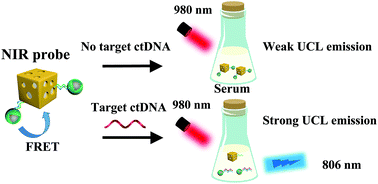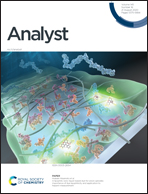Upconversion nanoparticle and gold nanocage satellite assemblies for sensitive ctDNA detection in serum†
Abstract
A rapid molecular diagnostic technique targeting circulating tumor DNA (ctDNA) has become one of the most clinically significant liquid biopsy methods for non-invasive and timely diagnosis of cancer. Herein, a sensitive detection system of ctDNA based on a fluorescence resonance energy transfer (FRET) system using upconversion nanoparticles (UCNPs) and gold nanocages (AuNCs) was constructed. Through the doping of Yb and Tm ions, the excitation and emission wavelengths of UCNPs were adjusted to 980 nm and 806 nm, respectively. Subsequently, UCNPs and AuNCs with the corresponding wavelength absorption were linked by complementary pairing of surface-modified DNA to form near-infrared fluorescent nanoprobes (NIR probes). Targeting DNA mutation recognition and signal transduction were realized by using NIR probes through the toehold-mediated strand displacement reaction. This method could detect a single point mutation of the KRAS gene with a wide detection range from 5 pM to 1000 pM and the limit of detection reached 6.30 pM. More importantly, the stable and highly specific NIR probes could be directly used in the serum environment without complicated pretreatment and amplification processes in advance. It could be envisioned that this specific and sensitive ctDNA detection strategy has great potential in clinical diagnosis and monitoring of diverse malignant tumors.



 Please wait while we load your content...
Please wait while we load your content...